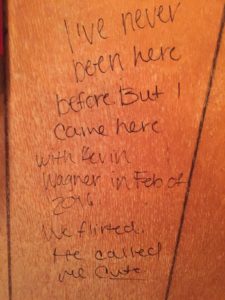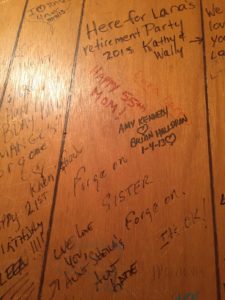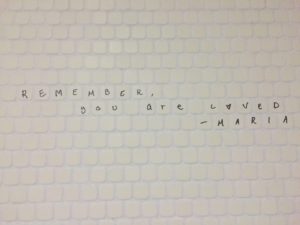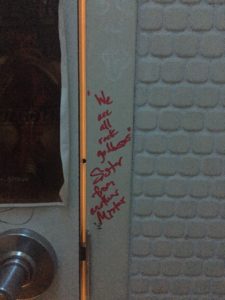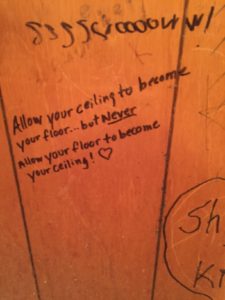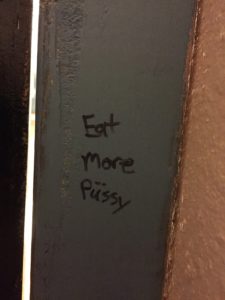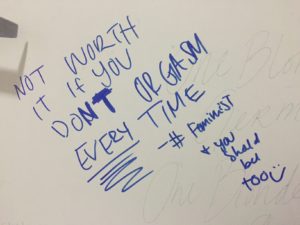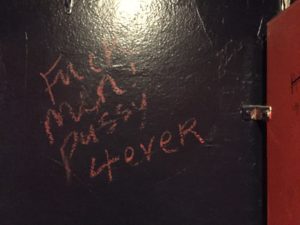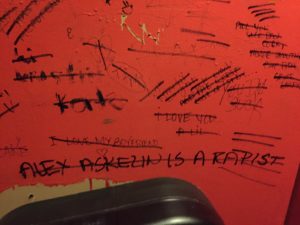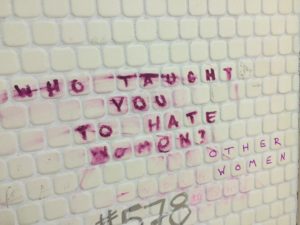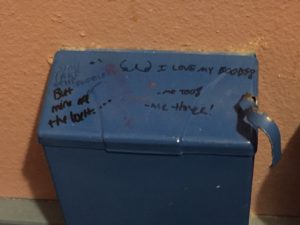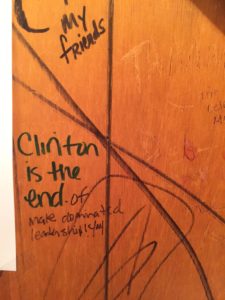The Enduring Wisdom (and Subversion) of Bathroom Graffiti
published in The Establishment, Feb. 6, 2017
While an undergrad at Yale, one of my favorite places to spend time was the Cross Campus Library (CCL)* — specifically the women’s bathroom in the basement. In truth, this was where I was exposed to some of the most provocative, intellectual discourse of my college years—these anonymous and hastily scrawled conversations were arguably more stimulating than the ones taking place in the hallowed halls and classrooms.
While there were far prettier spots to study, I began making it a habit to work in CCL so that I could check the restroom for new graffiti. Letting my eyes wander the beige stalls, I encountered raw, sometimes crude, and often very witty commentary, giving voice to views on lofty topics (sex, politics, feminism) and some less so (hot TAs, body hair, how much Harvard sucks). Some scribbles shared advice, or offered encouraging messages of solidarity; others expressed rage, usually directed at both specific men and The Man.
One lengthy exchange stands out in my memory. It began with a question: “When do you become a woman?” What followed was a series of answers, and critiques of others’ responses, which ranged from “when you get your period” and “when you learn to sway your hips” to “whenever the fuck you decide to be one.” There were at least a dozen different entries, enough material for me to write a brief essay for my Intro to Women’s Studies course one semester.
I was always too chicken to deface university property, so I never joined in the debate, but their words got me thinking about how my gender intersects with other parts of my identity. And I was thrilled to have discovered a new arena for uncensored discussion, where people could say whatever they wanted and not worry about the consequences.
Graffiti occupies a unique rhetorical space — it’s an undeniably transgressive act, and yet most leave their work unsigned, rendering it easily dismissible as thoughtless vandalism. The cloak of anonymity arguably raises questions about the strength of the convictions being articulated, but also gives the writer a certain freedom to be, perhaps, more honest. Trans and cis women are also given equal footing to express their experiences of womanhood by the anonymity granted through graffiti.
Beyond that, bathroom graffiti is fascinating to me because the viewer is a rather captive audience; it’s hard not to read text that’s two feet away from your face. In fact, it would take more effort to not read it.
Over the past year, I have been collecting images from restrooms located primarily in bars around the Upper Midwest, where I now live. You might think the graffiti from a cash-only dive in small town Wisconsin would bear little resemblance to what I saw in an Ivy League library over a decade ago, but surprisingly, it’s not all that different. The purpose of my project is to explore communication in a space that’s simultaneously private — intimate, even — but also public, trafficked by untold numbers of people. I have organized the photos into five categories to create a heuristic that visually represents the different kinds of things we feel compelled to write while afforded the temporary seclusion of a locked stall.
Of course, some of the things I read both back at Yale and while preparing this project might not even have been written by women at all, but transmasculine or nonbinary people for whom the women’s bathroom was the best (or only legal) option. For clarity’s sake, the word “women” is used here to describe all ladies’ room graffiti artists, with the understanding that the gender spectrum is actually far more complex.
*After renovation in 2007, it’s now known as the Anne T. & Robert M. Bass library
She Was Here: Memorializing and Documenting
Sometimes you just need to leave evidence that you existed, were in love, or saw that band before they got big or broke up. (Or just to tell the world that a guy named Kevin flirted with you and called you cute.)
Wisdom and Empowerment
In an ideal world, all bathrooms would be gender neutral, but until then, I suspect this category is the most gender-specific; from what I can tell, men don’t typically write things like this in “their” bathrooms. So many of the messages I discovered are encouraging, uplifting, inspirational — a pep talk from a woman you’ll never meet, your “sister from another mister.”
Let’s Talk About Sex
Not all graffiti in the ladies’ room is, ahem, “ladylike.” Frank — dare I say vulgar — discussion of bodies, bodily fluids, and sex are common tropes. I didn’t get a photo (utterly remiss on my part), but I was recently in a stall where someone claimed, in bold red marker, that her “cunt smelled like me Lucky Charms.”
Speaking Truth to Power
Are these women naming their own rapists? Are these intended as warnings to women who might know these men? Who crossed out everything in black marker and why? Why do women sometimes hate on other women, so much so that they feel compelled to tear them down on a bathroom stall, insulting their “short bangs” and “nasty clothes”?
These feel political. They feel angry. They are voices that refuse to be silenced.
She Said, She Said, or Conversation Pieces
Just like on social media, certain statements trigger lengthy comment threads. These tend to be my favorite type of graffiti because I love the idea of women anonymously conversing in dialogue. Responding to someone else’s graffiti, rather than making your own statement, feels like a different impulse.
Gender Norm Challenges
This photo, taken by Sam Riedel at a Manhattan bar, exists within a subset of graffiti that’s particularly important, and resonant, in our current political climate: that which explores the gender spectrum while challenging cis heteronormativity.
I realize not everyone may feel this way, but when I’m sitting on the pot, I like reading the messages and imagining those who wrote them, and what was going on in their lives that day or night. Did they know going in that they would write something and come prepared with a Sharpie? Did the impulse strike unexpectedly? Did they read something so angering, so beautiful, that they rooted around their purse or asked their neighbor for a pen?
All writing is transactional, and profound or not, these anonymous writers want their words to be read. By reading, I am participating, which makes me feel like I’m part of a community, a secret club of sorts. As commonplace as bathroom graffiti may be, there is something strangely liberating about engaging with text in a medium free of constraints, where nothing, seemingly, is taboo.
No language is too foul, no sentiment too crude. You can sign your name or not, put down a date or not, write something absurd or sincere. It might just be the freest speech there is.


